Asthma Case Study: Pathophysiology and Pharmacological Management
VerifiedAdded on 2021/06/16
|14
|3486
|28
Report
AI Summary
This report presents a comprehensive nursing case study focusing on a 7-year-old patient, Zacky, diagnosed with asthma. The first section delves into the pathophysiology of asthma, detailing the chronic inflammatory nature of the condition, the role of bronchoconstriction, and the clinical manifestations observed in the patient. It explores the cellular and molecular mechanisms underlying asthma, including the involvement of inflammatory cells and mediators. The second part of the report focuses on the pharmacological management of Zacky's asthma, discussing the pharmacodynamics of prescribed medications such as Ipatropium, Prednisolone, Salbutamol, Amoxicillin, and Paracetamol. It analyzes the mechanism of action, clinical considerations, and potential side effects of each drug. The report also outlines a prioritized care plan for the first 24 hours, emphasizing the stabilization of breathing, reduction of wheezing, and management of respiratory distress. The report provides a detailed overview of asthma, its management, and the significance of integrated care in pediatric patients. The patient's symptoms, medications, and nursing interventions are presented with an in-depth analysis.
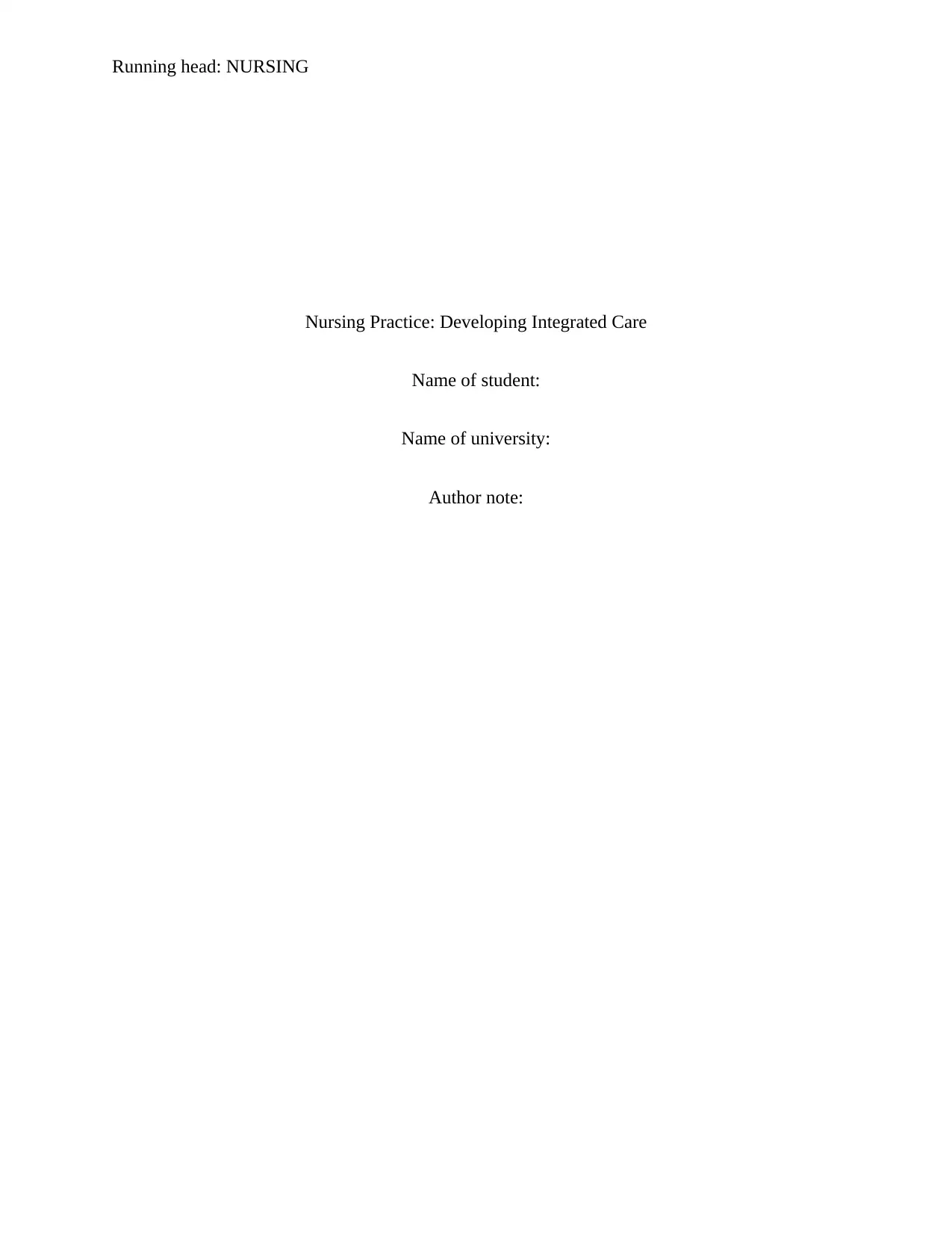
Running head: NURSING
Nursing Practice: Developing Integrated Care
Name of student:
Name of university:
Author note:
Nursing Practice: Developing Integrated Care
Name of student:
Name of university:
Author note:
Paraphrase This Document
Need a fresh take? Get an instant paraphrase of this document with our AI Paraphraser
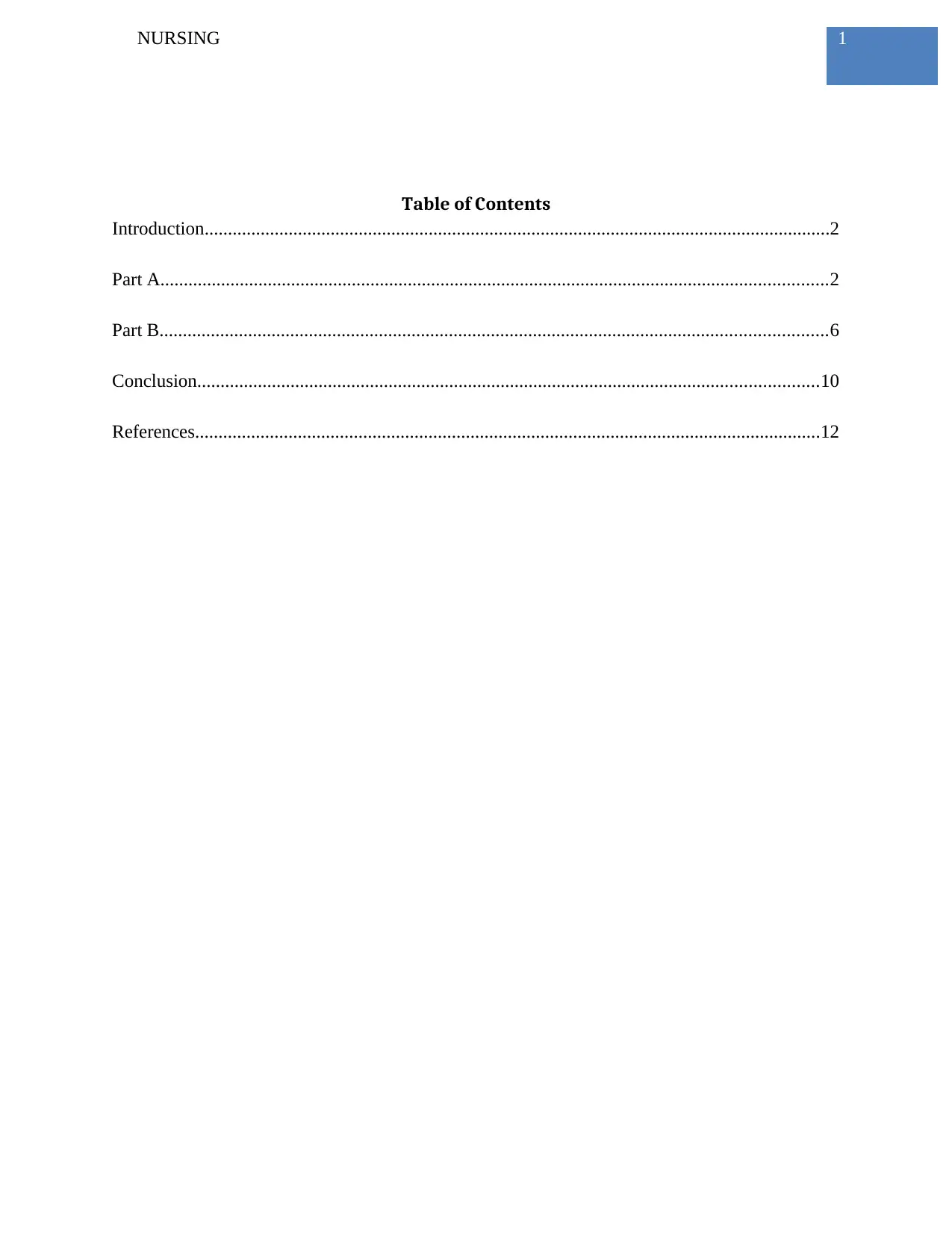
1NURSING
Table of Contents
Introduction......................................................................................................................................2
Part A...............................................................................................................................................2
Part B...............................................................................................................................................6
Conclusion.....................................................................................................................................10
References......................................................................................................................................12
Table of Contents
Introduction......................................................................................................................................2
Part A...............................................................................................................................................2
Part B...............................................................................................................................................6
Conclusion.....................................................................................................................................10
References......................................................................................................................................12
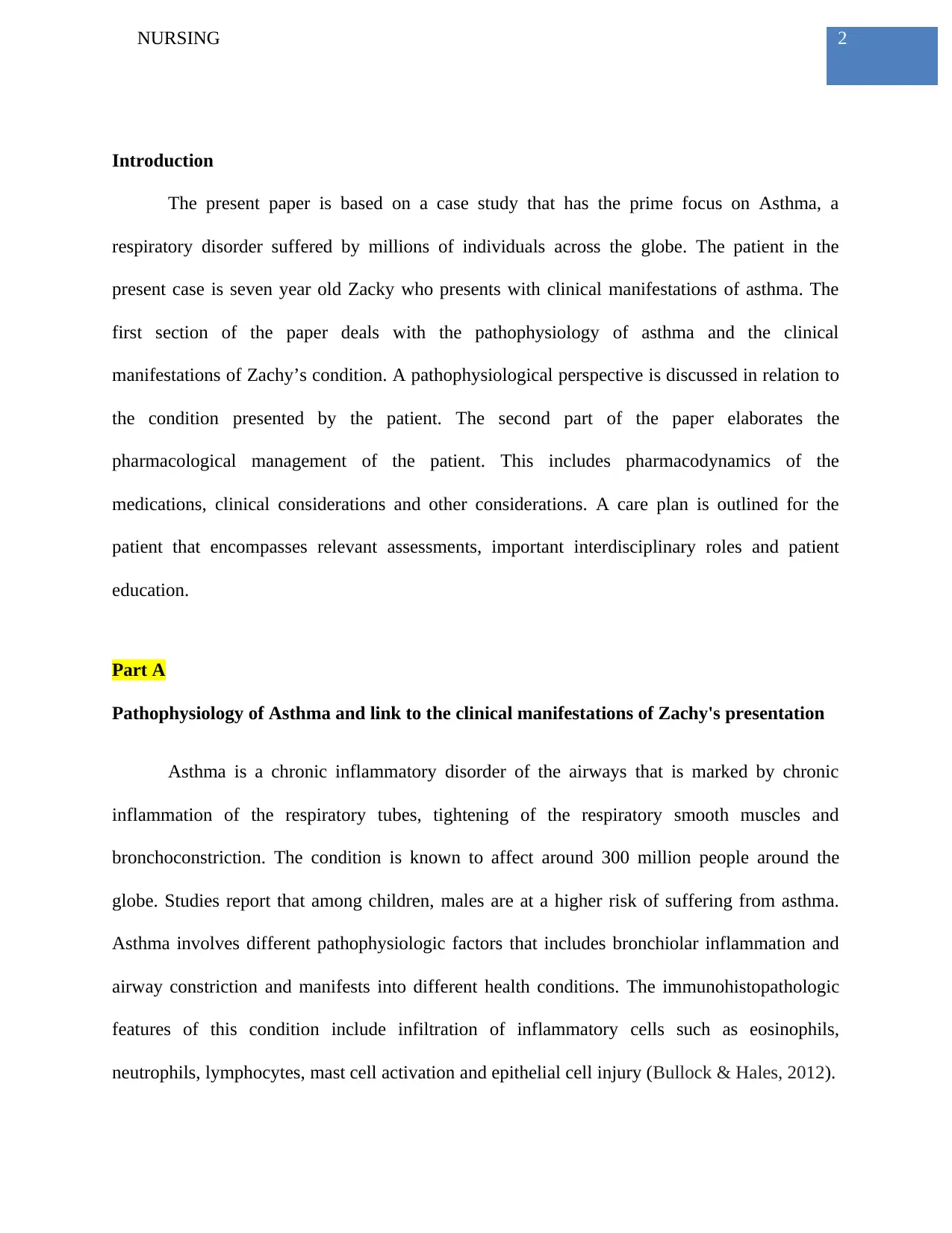
2NURSING
Introduction
The present paper is based on a case study that has the prime focus on Asthma, a
respiratory disorder suffered by millions of individuals across the globe. The patient in the
present case is seven year old Zacky who presents with clinical manifestations of asthma. The
first section of the paper deals with the pathophysiology of asthma and the clinical
manifestations of Zachy’s condition. A pathophysiological perspective is discussed in relation to
the condition presented by the patient. The second part of the paper elaborates the
pharmacological management of the patient. This includes pharmacodynamics of the
medications, clinical considerations and other considerations. A care plan is outlined for the
patient that encompasses relevant assessments, important interdisciplinary roles and patient
education.
Part A
Pathophysiology of Asthma and link to the clinical manifestations of Zachy's presentation
Asthma is a chronic inflammatory disorder of the airways that is marked by chronic
inflammation of the respiratory tubes, tightening of the respiratory smooth muscles and
bronchoconstriction. The condition is known to affect around 300 million people around the
globe. Studies report that among children, males are at a higher risk of suffering from asthma.
Asthma involves different pathophysiologic factors that includes bronchiolar inflammation and
airway constriction and manifests into different health conditions. The immunohistopathologic
features of this condition include infiltration of inflammatory cells such as eosinophils,
neutrophils, lymphocytes, mast cell activation and epithelial cell injury (Bullock & Hales, 2012).
Introduction
The present paper is based on a case study that has the prime focus on Asthma, a
respiratory disorder suffered by millions of individuals across the globe. The patient in the
present case is seven year old Zacky who presents with clinical manifestations of asthma. The
first section of the paper deals with the pathophysiology of asthma and the clinical
manifestations of Zachy’s condition. A pathophysiological perspective is discussed in relation to
the condition presented by the patient. The second part of the paper elaborates the
pharmacological management of the patient. This includes pharmacodynamics of the
medications, clinical considerations and other considerations. A care plan is outlined for the
patient that encompasses relevant assessments, important interdisciplinary roles and patient
education.
Part A
Pathophysiology of Asthma and link to the clinical manifestations of Zachy's presentation
Asthma is a chronic inflammatory disorder of the airways that is marked by chronic
inflammation of the respiratory tubes, tightening of the respiratory smooth muscles and
bronchoconstriction. The condition is known to affect around 300 million people around the
globe. Studies report that among children, males are at a higher risk of suffering from asthma.
Asthma involves different pathophysiologic factors that includes bronchiolar inflammation and
airway constriction and manifests into different health conditions. The immunohistopathologic
features of this condition include infiltration of inflammatory cells such as eosinophils,
neutrophils, lymphocytes, mast cell activation and epithelial cell injury (Bullock & Hales, 2012).
⊘ This is a preview!⊘
Do you want full access?
Subscribe today to unlock all pages.

Trusted by 1+ million students worldwide
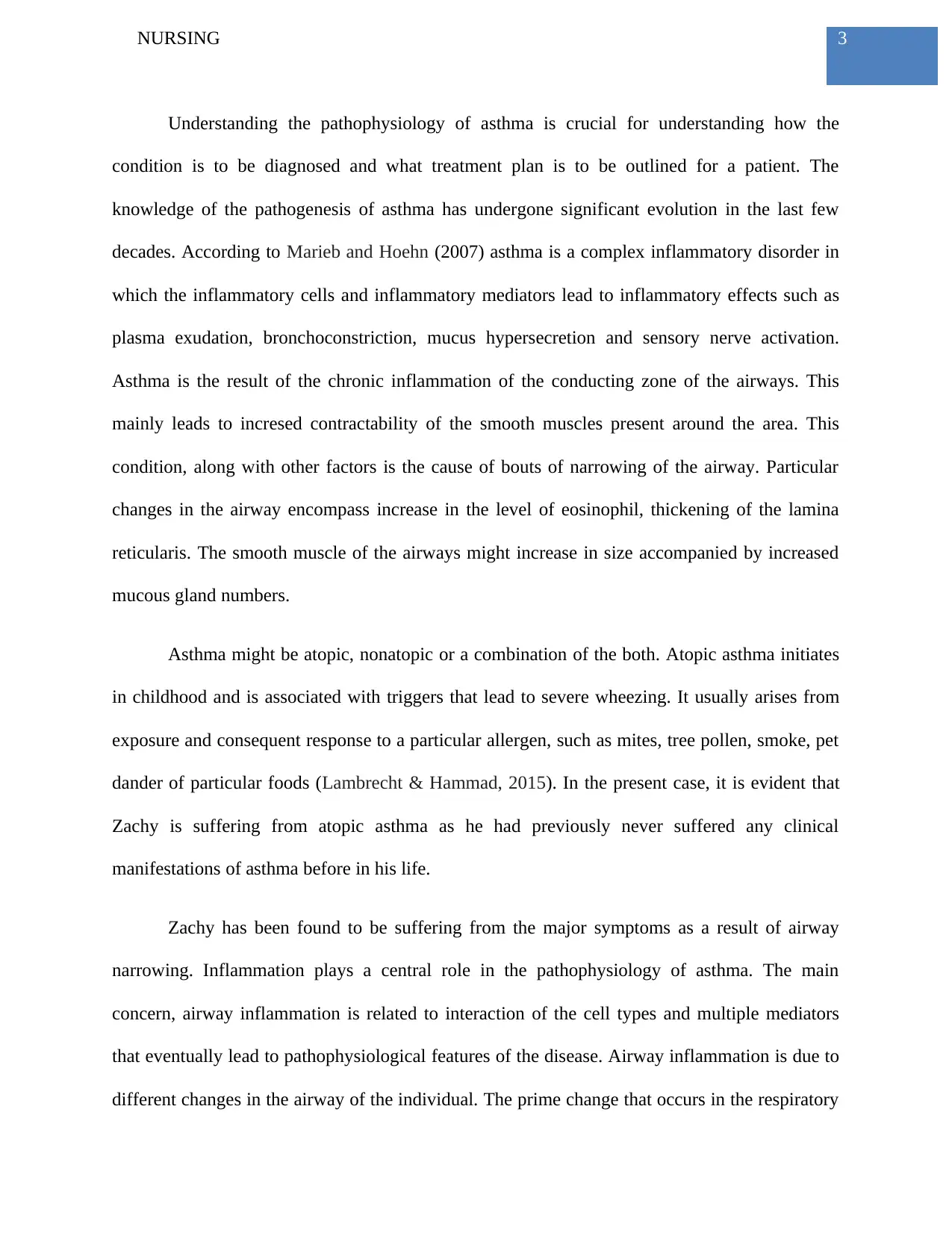
3NURSING
Understanding the pathophysiology of asthma is crucial for understanding how the
condition is to be diagnosed and what treatment plan is to be outlined for a patient. The
knowledge of the pathogenesis of asthma has undergone significant evolution in the last few
decades. According to Marieb and Hoehn (2007) asthma is a complex inflammatory disorder in
which the inflammatory cells and inflammatory mediators lead to inflammatory effects such as
plasma exudation, bronchoconstriction, mucus hypersecretion and sensory nerve activation.
Asthma is the result of the chronic inflammation of the conducting zone of the airways. This
mainly leads to incresed contractability of the smooth muscles present around the area. This
condition, along with other factors is the cause of bouts of narrowing of the airway. Particular
changes in the airway encompass increase in the level of eosinophil, thickening of the lamina
reticularis. The smooth muscle of the airways might increase in size accompanied by increased
mucous gland numbers.
Asthma might be atopic, nonatopic or a combination of the both. Atopic asthma initiates
in childhood and is associated with triggers that lead to severe wheezing. It usually arises from
exposure and consequent response to a particular allergen, such as mites, tree pollen, smoke, pet
dander of particular foods (Lambrecht & Hammad, 2015). In the present case, it is evident that
Zachy is suffering from atopic asthma as he had previously never suffered any clinical
manifestations of asthma before in his life.
Zachy has been found to be suffering from the major symptoms as a result of airway
narrowing. Inflammation plays a central role in the pathophysiology of asthma. The main
concern, airway inflammation is related to interaction of the cell types and multiple mediators
that eventually lead to pathophysiological features of the disease. Airway inflammation is due to
different changes in the airway of the individual. The prime change that occurs in the respiratory
Understanding the pathophysiology of asthma is crucial for understanding how the
condition is to be diagnosed and what treatment plan is to be outlined for a patient. The
knowledge of the pathogenesis of asthma has undergone significant evolution in the last few
decades. According to Marieb and Hoehn (2007) asthma is a complex inflammatory disorder in
which the inflammatory cells and inflammatory mediators lead to inflammatory effects such as
plasma exudation, bronchoconstriction, mucus hypersecretion and sensory nerve activation.
Asthma is the result of the chronic inflammation of the conducting zone of the airways. This
mainly leads to incresed contractability of the smooth muscles present around the area. This
condition, along with other factors is the cause of bouts of narrowing of the airway. Particular
changes in the airway encompass increase in the level of eosinophil, thickening of the lamina
reticularis. The smooth muscle of the airways might increase in size accompanied by increased
mucous gland numbers.
Asthma might be atopic, nonatopic or a combination of the both. Atopic asthma initiates
in childhood and is associated with triggers that lead to severe wheezing. It usually arises from
exposure and consequent response to a particular allergen, such as mites, tree pollen, smoke, pet
dander of particular foods (Lambrecht & Hammad, 2015). In the present case, it is evident that
Zachy is suffering from atopic asthma as he had previously never suffered any clinical
manifestations of asthma before in his life.
Zachy has been found to be suffering from the major symptoms as a result of airway
narrowing. Inflammation plays a central role in the pathophysiology of asthma. The main
concern, airway inflammation is related to interaction of the cell types and multiple mediators
that eventually lead to pathophysiological features of the disease. Airway inflammation is due to
different changes in the airway of the individual. The prime change that occurs in the respiratory
Paraphrase This Document
Need a fresh take? Get an instant paraphrase of this document with our AI Paraphraser
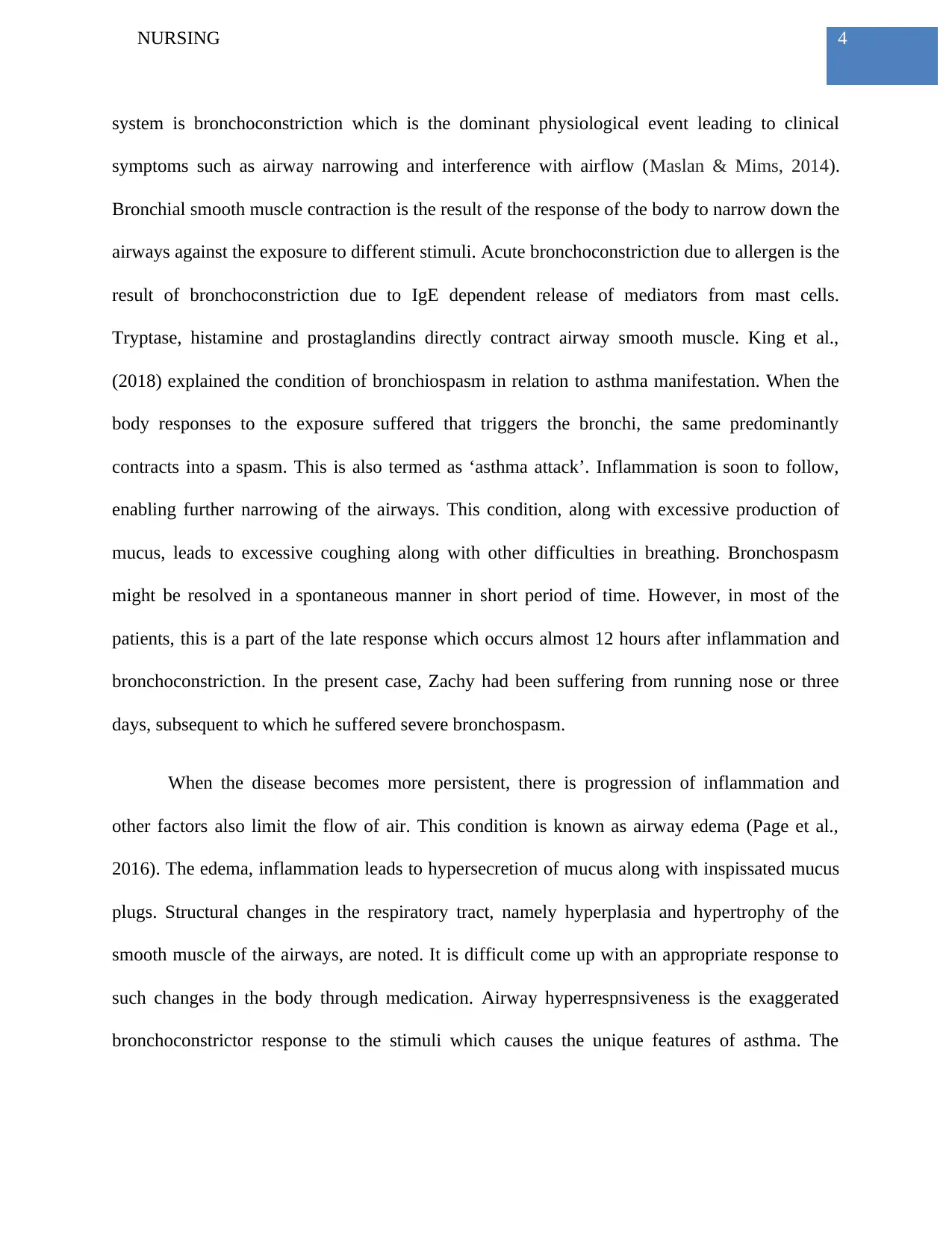
4NURSING
system is bronchoconstriction which is the dominant physiological event leading to clinical
symptoms such as airway narrowing and interference with airflow (Maslan & Mims, 2014).
Bronchial smooth muscle contraction is the result of the response of the body to narrow down the
airways against the exposure to different stimuli. Acute bronchoconstriction due to allergen is the
result of bronchoconstriction due to IgE dependent release of mediators from mast cells.
Tryptase, histamine and prostaglandins directly contract airway smooth muscle. King et al.,
(2018) explained the condition of bronchiospasm in relation to asthma manifestation. When the
body responses to the exposure suffered that triggers the bronchi, the same predominantly
contracts into a spasm. This is also termed as ‘asthma attack’. Inflammation is soon to follow,
enabling further narrowing of the airways. This condition, along with excessive production of
mucus, leads to excessive coughing along with other difficulties in breathing. Bronchospasm
might be resolved in a spontaneous manner in short period of time. However, in most of the
patients, this is a part of the late response which occurs almost 12 hours after inflammation and
bronchoconstriction. In the present case, Zachy had been suffering from running nose or three
days, subsequent to which he suffered severe bronchospasm.
When the disease becomes more persistent, there is progression of inflammation and
other factors also limit the flow of air. This condition is known as airway edema (Page et al.,
2016). The edema, inflammation leads to hypersecretion of mucus along with inspissated mucus
plugs. Structural changes in the respiratory tract, namely hyperplasia and hypertrophy of the
smooth muscle of the airways, are noted. It is difficult come up with an appropriate response to
such changes in the body through medication. Airway hyperrespnsiveness is the exaggerated
bronchoconstrictor response to the stimuli which causes the unique features of asthma. The
system is bronchoconstriction which is the dominant physiological event leading to clinical
symptoms such as airway narrowing and interference with airflow (Maslan & Mims, 2014).
Bronchial smooth muscle contraction is the result of the response of the body to narrow down the
airways against the exposure to different stimuli. Acute bronchoconstriction due to allergen is the
result of bronchoconstriction due to IgE dependent release of mediators from mast cells.
Tryptase, histamine and prostaglandins directly contract airway smooth muscle. King et al.,
(2018) explained the condition of bronchiospasm in relation to asthma manifestation. When the
body responses to the exposure suffered that triggers the bronchi, the same predominantly
contracts into a spasm. This is also termed as ‘asthma attack’. Inflammation is soon to follow,
enabling further narrowing of the airways. This condition, along with excessive production of
mucus, leads to excessive coughing along with other difficulties in breathing. Bronchospasm
might be resolved in a spontaneous manner in short period of time. However, in most of the
patients, this is a part of the late response which occurs almost 12 hours after inflammation and
bronchoconstriction. In the present case, Zachy had been suffering from running nose or three
days, subsequent to which he suffered severe bronchospasm.
When the disease becomes more persistent, there is progression of inflammation and
other factors also limit the flow of air. This condition is known as airway edema (Page et al.,
2016). The edema, inflammation leads to hypersecretion of mucus along with inspissated mucus
plugs. Structural changes in the respiratory tract, namely hyperplasia and hypertrophy of the
smooth muscle of the airways, are noted. It is difficult come up with an appropriate response to
such changes in the body through medication. Airway hyperrespnsiveness is the exaggerated
bronchoconstrictor response to the stimuli which causes the unique features of asthma. The
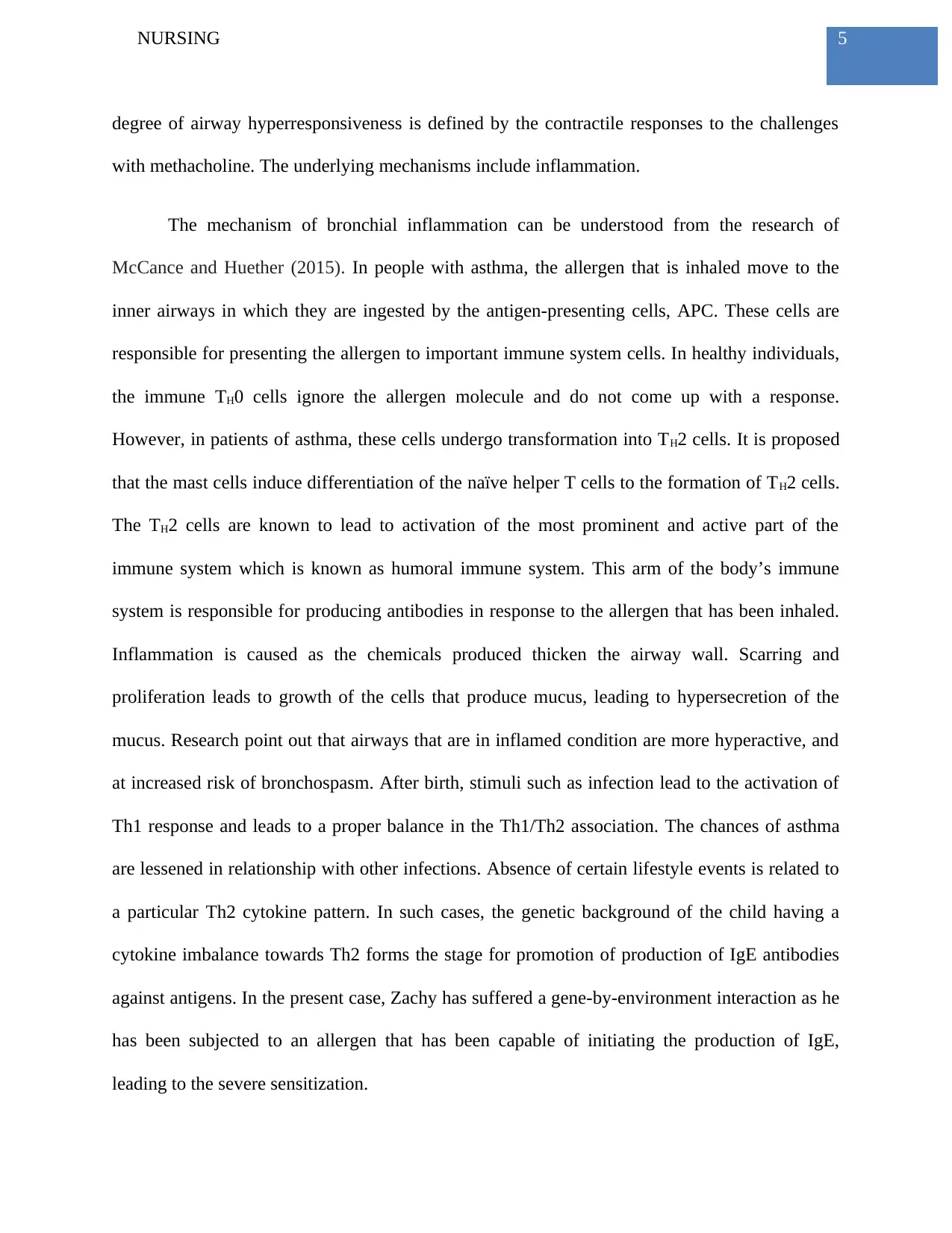
5NURSING
degree of airway hyperresponsiveness is defined by the contractile responses to the challenges
with methacholine. The underlying mechanisms include inflammation.
The mechanism of bronchial inflammation can be understood from the research of
McCance and Huether (2015). In people with asthma, the allergen that is inhaled move to the
inner airways in which they are ingested by the antigen-presenting cells, APC. These cells are
responsible for presenting the allergen to important immune system cells. In healthy individuals,
the immune TH0 cells ignore the allergen molecule and do not come up with a response.
However, in patients of asthma, these cells undergo transformation into TH2 cells. It is proposed
that the mast cells induce differentiation of the naïve helper T cells to the formation of TH2 cells.
The TH2 cells are known to lead to activation of the most prominent and active part of the
immune system which is known as humoral immune system. This arm of the body’s immune
system is responsible for producing antibodies in response to the allergen that has been inhaled.
Inflammation is caused as the chemicals produced thicken the airway wall. Scarring and
proliferation leads to growth of the cells that produce mucus, leading to hypersecretion of the
mucus. Research point out that airways that are in inflamed condition are more hyperactive, and
at increased risk of bronchospasm. After birth, stimuli such as infection lead to the activation of
Th1 response and leads to a proper balance in the Th1/Th2 association. The chances of asthma
are lessened in relationship with other infections. Absence of certain lifestyle events is related to
a particular Th2 cytokine pattern. In such cases, the genetic background of the child having a
cytokine imbalance towards Th2 forms the stage for promotion of production of IgE antibodies
against antigens. In the present case, Zachy has suffered a gene-by-environment interaction as he
has been subjected to an allergen that has been capable of initiating the production of IgE,
leading to the severe sensitization.
degree of airway hyperresponsiveness is defined by the contractile responses to the challenges
with methacholine. The underlying mechanisms include inflammation.
The mechanism of bronchial inflammation can be understood from the research of
McCance and Huether (2015). In people with asthma, the allergen that is inhaled move to the
inner airways in which they are ingested by the antigen-presenting cells, APC. These cells are
responsible for presenting the allergen to important immune system cells. In healthy individuals,
the immune TH0 cells ignore the allergen molecule and do not come up with a response.
However, in patients of asthma, these cells undergo transformation into TH2 cells. It is proposed
that the mast cells induce differentiation of the naïve helper T cells to the formation of TH2 cells.
The TH2 cells are known to lead to activation of the most prominent and active part of the
immune system which is known as humoral immune system. This arm of the body’s immune
system is responsible for producing antibodies in response to the allergen that has been inhaled.
Inflammation is caused as the chemicals produced thicken the airway wall. Scarring and
proliferation leads to growth of the cells that produce mucus, leading to hypersecretion of the
mucus. Research point out that airways that are in inflamed condition are more hyperactive, and
at increased risk of bronchospasm. After birth, stimuli such as infection lead to the activation of
Th1 response and leads to a proper balance in the Th1/Th2 association. The chances of asthma
are lessened in relationship with other infections. Absence of certain lifestyle events is related to
a particular Th2 cytokine pattern. In such cases, the genetic background of the child having a
cytokine imbalance towards Th2 forms the stage for promotion of production of IgE antibodies
against antigens. In the present case, Zachy has suffered a gene-by-environment interaction as he
has been subjected to an allergen that has been capable of initiating the production of IgE,
leading to the severe sensitization.
⊘ This is a preview!⊘
Do you want full access?
Subscribe today to unlock all pages.

Trusted by 1+ million students worldwide
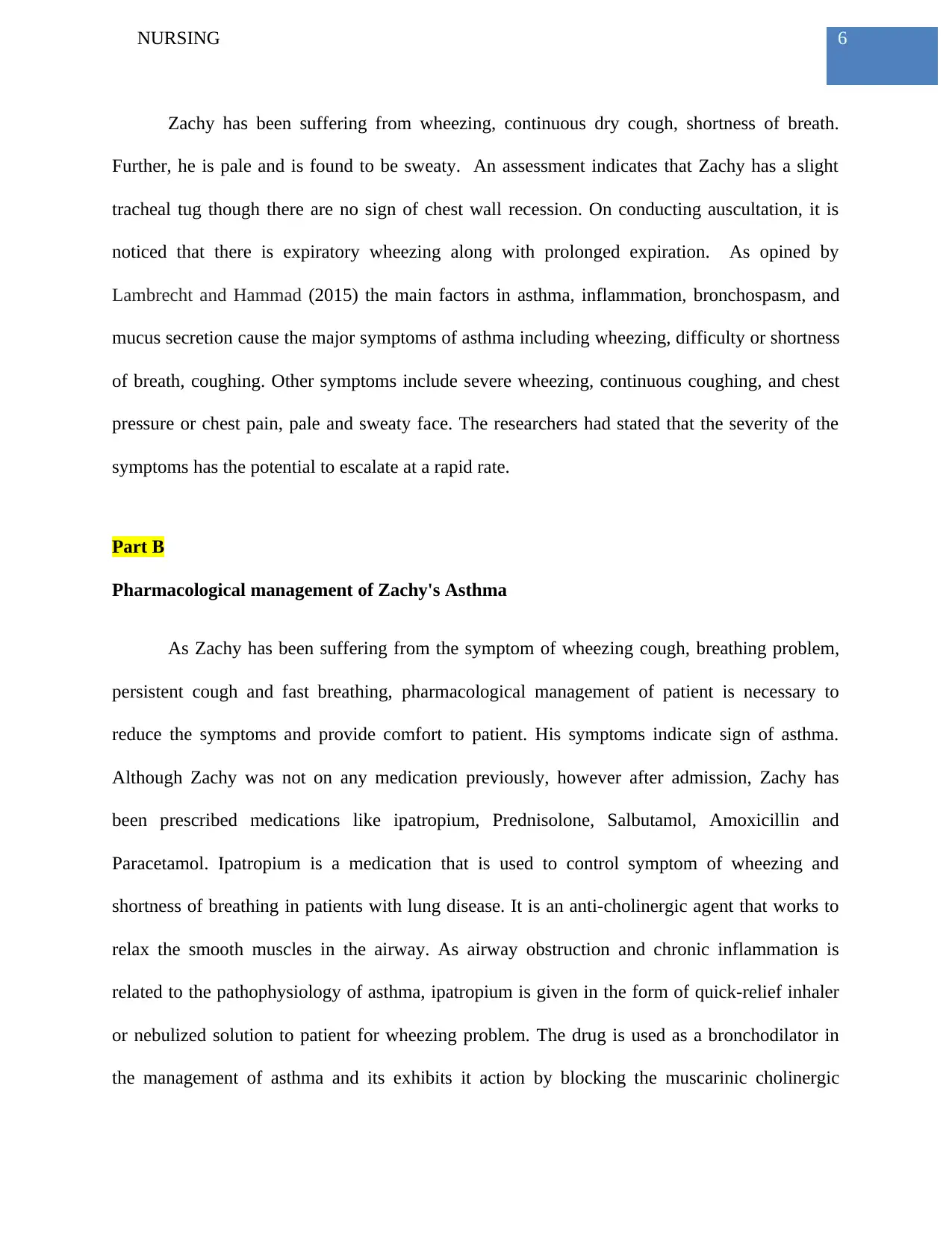
6NURSING
Zachy has been suffering from wheezing, continuous dry cough, shortness of breath.
Further, he is pale and is found to be sweaty. An assessment indicates that Zachy has a slight
tracheal tug though there are no sign of chest wall recession. On conducting auscultation, it is
noticed that there is expiratory wheezing along with prolonged expiration. As opined by
Lambrecht and Hammad (2015) the main factors in asthma, inflammation, bronchospasm, and
mucus secretion cause the major symptoms of asthma including wheezing, difficulty or shortness
of breath, coughing. Other symptoms include severe wheezing, continuous coughing, and chest
pressure or chest pain, pale and sweaty face. The researchers had stated that the severity of the
symptoms has the potential to escalate at a rapid rate.
Part B
Pharmacological management of Zachy's Asthma
As Zachy has been suffering from the symptom of wheezing cough, breathing problem,
persistent cough and fast breathing, pharmacological management of patient is necessary to
reduce the symptoms and provide comfort to patient. His symptoms indicate sign of asthma.
Although Zachy was not on any medication previously, however after admission, Zachy has
been prescribed medications like ipatropium, Prednisolone, Salbutamol, Amoxicillin and
Paracetamol. Ipatropium is a medication that is used to control symptom of wheezing and
shortness of breathing in patients with lung disease. It is an anti-cholinergic agent that works to
relax the smooth muscles in the airway. As airway obstruction and chronic inflammation is
related to the pathophysiology of asthma, ipatropium is given in the form of quick-relief inhaler
or nebulized solution to patient for wheezing problem. The drug is used as a bronchodilator in
the management of asthma and its exhibits it action by blocking the muscarinic cholinergic
Zachy has been suffering from wheezing, continuous dry cough, shortness of breath.
Further, he is pale and is found to be sweaty. An assessment indicates that Zachy has a slight
tracheal tug though there are no sign of chest wall recession. On conducting auscultation, it is
noticed that there is expiratory wheezing along with prolonged expiration. As opined by
Lambrecht and Hammad (2015) the main factors in asthma, inflammation, bronchospasm, and
mucus secretion cause the major symptoms of asthma including wheezing, difficulty or shortness
of breath, coughing. Other symptoms include severe wheezing, continuous coughing, and chest
pressure or chest pain, pale and sweaty face. The researchers had stated that the severity of the
symptoms has the potential to escalate at a rapid rate.
Part B
Pharmacological management of Zachy's Asthma
As Zachy has been suffering from the symptom of wheezing cough, breathing problem,
persistent cough and fast breathing, pharmacological management of patient is necessary to
reduce the symptoms and provide comfort to patient. His symptoms indicate sign of asthma.
Although Zachy was not on any medication previously, however after admission, Zachy has
been prescribed medications like ipatropium, Prednisolone, Salbutamol, Amoxicillin and
Paracetamol. Ipatropium is a medication that is used to control symptom of wheezing and
shortness of breathing in patients with lung disease. It is an anti-cholinergic agent that works to
relax the smooth muscles in the airway. As airway obstruction and chronic inflammation is
related to the pathophysiology of asthma, ipatropium is given in the form of quick-relief inhaler
or nebulized solution to patient for wheezing problem. The drug is used as a bronchodilator in
the management of asthma and its exhibits it action by blocking the muscarinic cholinergic
Paraphrase This Document
Need a fresh take? Get an instant paraphrase of this document with our AI Paraphraser
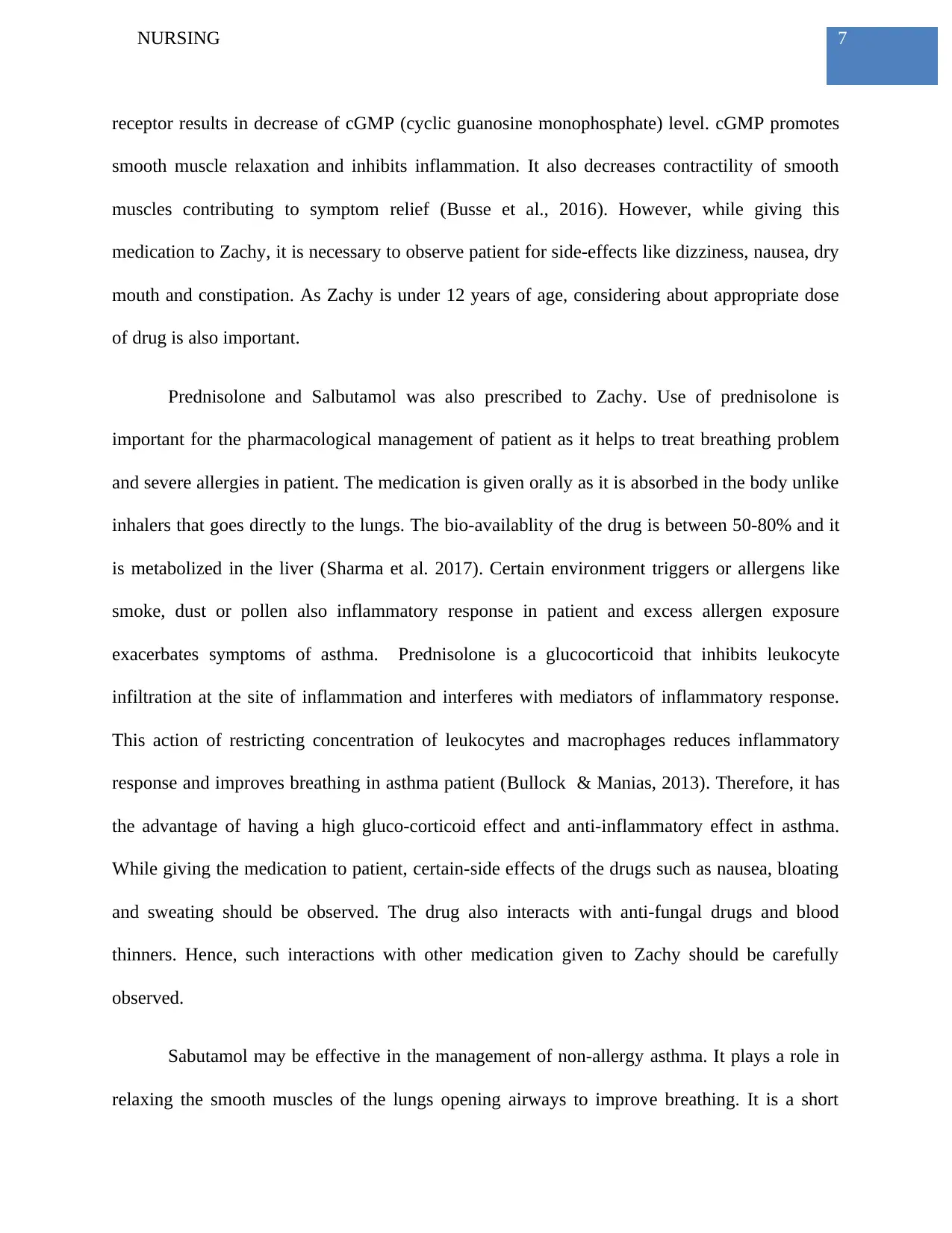
7NURSING
receptor results in decrease of cGMP (cyclic guanosine monophosphate) level. cGMP promotes
smooth muscle relaxation and inhibits inflammation. It also decreases contractility of smooth
muscles contributing to symptom relief (Busse et al., 2016). However, while giving this
medication to Zachy, it is necessary to observe patient for side-effects like dizziness, nausea, dry
mouth and constipation. As Zachy is under 12 years of age, considering about appropriate dose
of drug is also important.
Prednisolone and Salbutamol was also prescribed to Zachy. Use of prednisolone is
important for the pharmacological management of patient as it helps to treat breathing problem
and severe allergies in patient. The medication is given orally as it is absorbed in the body unlike
inhalers that goes directly to the lungs. The bio-availablity of the drug is between 50-80% and it
is metabolized in the liver (Sharma et al. 2017). Certain environment triggers or allergens like
smoke, dust or pollen also inflammatory response in patient and excess allergen exposure
exacerbates symptoms of asthma. Prednisolone is a glucocorticoid that inhibits leukocyte
infiltration at the site of inflammation and interferes with mediators of inflammatory response.
This action of restricting concentration of leukocytes and macrophages reduces inflammatory
response and improves breathing in asthma patient (Bullock & Manias, 2013). Therefore, it has
the advantage of having a high gluco-corticoid effect and anti-inflammatory effect in asthma.
While giving the medication to patient, certain-side effects of the drugs such as nausea, bloating
and sweating should be observed. The drug also interacts with anti-fungal drugs and blood
thinners. Hence, such interactions with other medication given to Zachy should be carefully
observed.
Sabutamol may be effective in the management of non-allergy asthma. It plays a role in
relaxing the smooth muscles of the lungs opening airways to improve breathing. It is a short
receptor results in decrease of cGMP (cyclic guanosine monophosphate) level. cGMP promotes
smooth muscle relaxation and inhibits inflammation. It also decreases contractility of smooth
muscles contributing to symptom relief (Busse et al., 2016). However, while giving this
medication to Zachy, it is necessary to observe patient for side-effects like dizziness, nausea, dry
mouth and constipation. As Zachy is under 12 years of age, considering about appropriate dose
of drug is also important.
Prednisolone and Salbutamol was also prescribed to Zachy. Use of prednisolone is
important for the pharmacological management of patient as it helps to treat breathing problem
and severe allergies in patient. The medication is given orally as it is absorbed in the body unlike
inhalers that goes directly to the lungs. The bio-availablity of the drug is between 50-80% and it
is metabolized in the liver (Sharma et al. 2017). Certain environment triggers or allergens like
smoke, dust or pollen also inflammatory response in patient and excess allergen exposure
exacerbates symptoms of asthma. Prednisolone is a glucocorticoid that inhibits leukocyte
infiltration at the site of inflammation and interferes with mediators of inflammatory response.
This action of restricting concentration of leukocytes and macrophages reduces inflammatory
response and improves breathing in asthma patient (Bullock & Manias, 2013). Therefore, it has
the advantage of having a high gluco-corticoid effect and anti-inflammatory effect in asthma.
While giving the medication to patient, certain-side effects of the drugs such as nausea, bloating
and sweating should be observed. The drug also interacts with anti-fungal drugs and blood
thinners. Hence, such interactions with other medication given to Zachy should be carefully
observed.
Sabutamol may be effective in the management of non-allergy asthma. It plays a role in
relaxing the smooth muscles of the lungs opening airways to improve breathing. It is a short
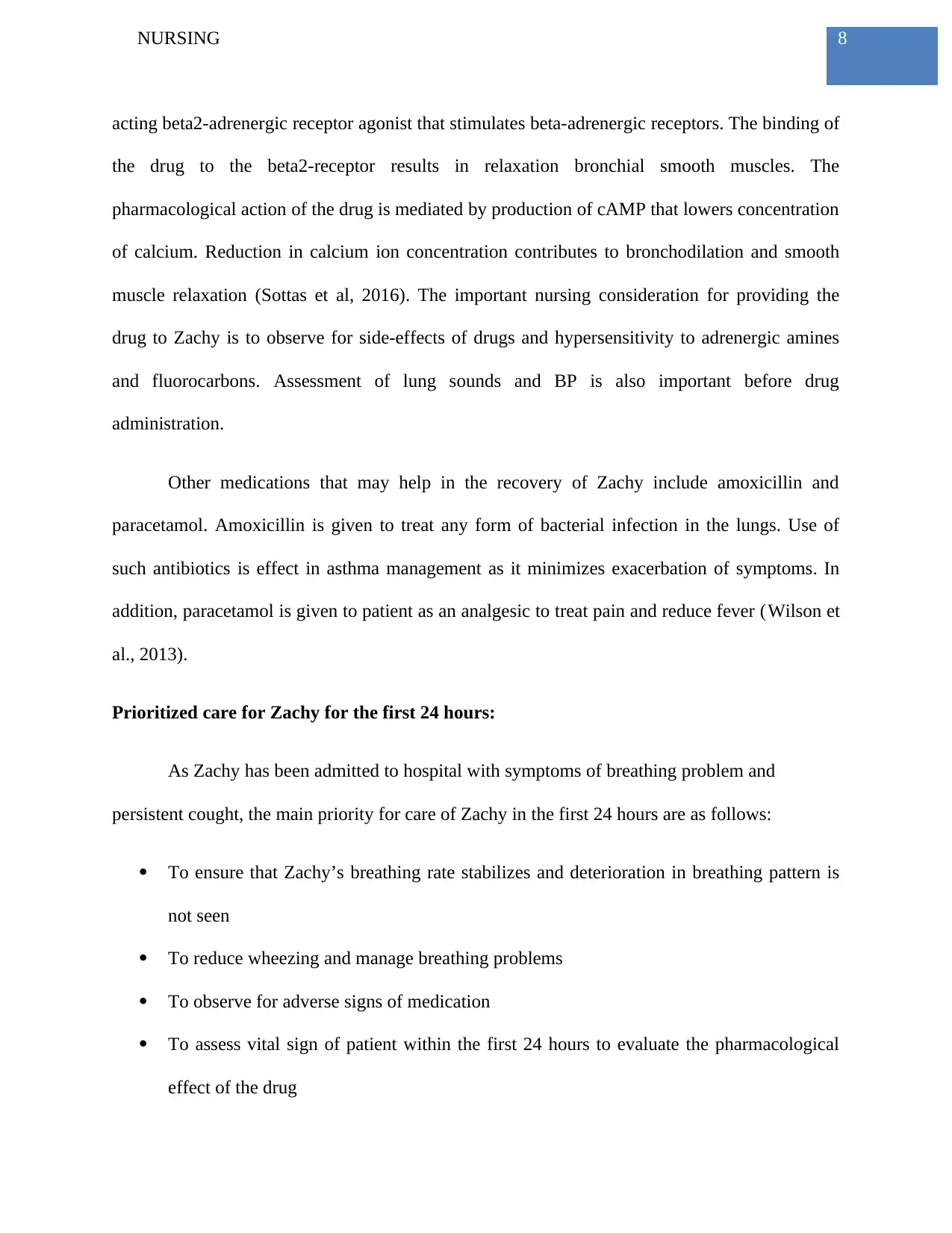
8NURSING
acting beta2-adrenergic receptor agonist that stimulates beta-adrenergic receptors. The binding of
the drug to the beta2-receptor results in relaxation bronchial smooth muscles. The
pharmacological action of the drug is mediated by production of cAMP that lowers concentration
of calcium. Reduction in calcium ion concentration contributes to bronchodilation and smooth
muscle relaxation (Sottas et al, 2016). The important nursing consideration for providing the
drug to Zachy is to observe for side-effects of drugs and hypersensitivity to adrenergic amines
and fluorocarbons. Assessment of lung sounds and BP is also important before drug
administration.
Other medications that may help in the recovery of Zachy include amoxicillin and
paracetamol. Amoxicillin is given to treat any form of bacterial infection in the lungs. Use of
such antibiotics is effect in asthma management as it minimizes exacerbation of symptoms. In
addition, paracetamol is given to patient as an analgesic to treat pain and reduce fever (Wilson et
al., 2013).
Prioritized care for Zachy for the first 24 hours:
As Zachy has been admitted to hospital with symptoms of breathing problem and
persistent cought, the main priority for care of Zachy in the first 24 hours are as follows:
To ensure that Zachy’s breathing rate stabilizes and deterioration in breathing pattern is
not seen
To reduce wheezing and manage breathing problems
To observe for adverse signs of medication
To assess vital sign of patient within the first 24 hours to evaluate the pharmacological
effect of the drug
acting beta2-adrenergic receptor agonist that stimulates beta-adrenergic receptors. The binding of
the drug to the beta2-receptor results in relaxation bronchial smooth muscles. The
pharmacological action of the drug is mediated by production of cAMP that lowers concentration
of calcium. Reduction in calcium ion concentration contributes to bronchodilation and smooth
muscle relaxation (Sottas et al, 2016). The important nursing consideration for providing the
drug to Zachy is to observe for side-effects of drugs and hypersensitivity to adrenergic amines
and fluorocarbons. Assessment of lung sounds and BP is also important before drug
administration.
Other medications that may help in the recovery of Zachy include amoxicillin and
paracetamol. Amoxicillin is given to treat any form of bacterial infection in the lungs. Use of
such antibiotics is effect in asthma management as it minimizes exacerbation of symptoms. In
addition, paracetamol is given to patient as an analgesic to treat pain and reduce fever (Wilson et
al., 2013).
Prioritized care for Zachy for the first 24 hours:
As Zachy has been admitted to hospital with symptoms of breathing problem and
persistent cought, the main priority for care of Zachy in the first 24 hours are as follows:
To ensure that Zachy’s breathing rate stabilizes and deterioration in breathing pattern is
not seen
To reduce wheezing and manage breathing problems
To observe for adverse signs of medication
To assess vital sign of patient within the first 24 hours to evaluate the pharmacological
effect of the drug
⊘ This is a preview!⊘
Do you want full access?
Subscribe today to unlock all pages.

Trusted by 1+ million students worldwide
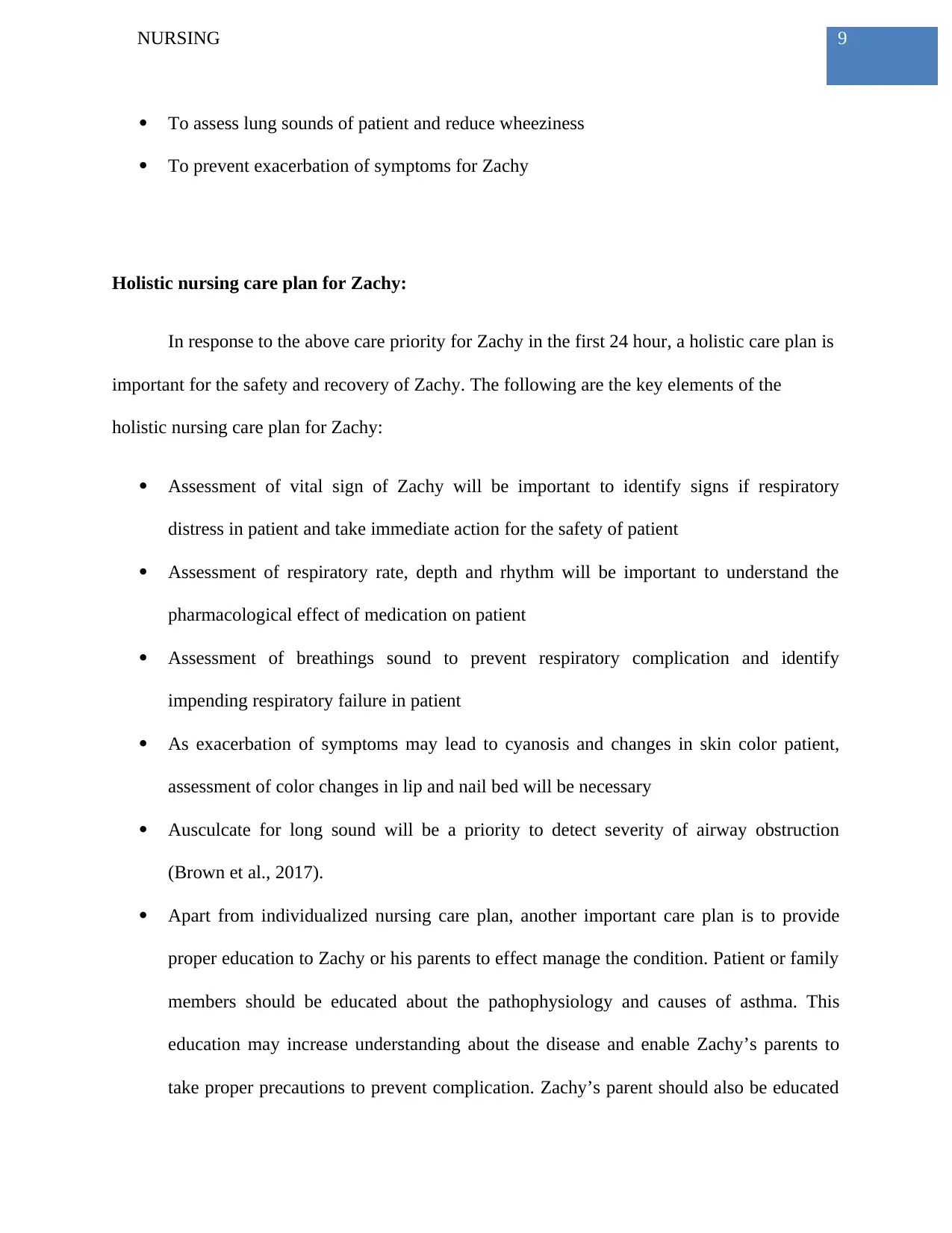
9NURSING
To assess lung sounds of patient and reduce wheeziness
To prevent exacerbation of symptoms for Zachy
Holistic nursing care plan for Zachy:
In response to the above care priority for Zachy in the first 24 hour, a holistic care plan is
important for the safety and recovery of Zachy. The following are the key elements of the
holistic nursing care plan for Zachy:
Assessment of vital sign of Zachy will be important to identify signs if respiratory
distress in patient and take immediate action for the safety of patient
Assessment of respiratory rate, depth and rhythm will be important to understand the
pharmacological effect of medication on patient
Assessment of breathings sound to prevent respiratory complication and identify
impending respiratory failure in patient
As exacerbation of symptoms may lead to cyanosis and changes in skin color patient,
assessment of color changes in lip and nail bed will be necessary
Ausculcate for long sound will be a priority to detect severity of airway obstruction
(Brown et al., 2017).
Apart from individualized nursing care plan, another important care plan is to provide
proper education to Zachy or his parents to effect manage the condition. Patient or family
members should be educated about the pathophysiology and causes of asthma. This
education may increase understanding about the disease and enable Zachy’s parents to
take proper precautions to prevent complication. Zachy’s parent should also be educated
To assess lung sounds of patient and reduce wheeziness
To prevent exacerbation of symptoms for Zachy
Holistic nursing care plan for Zachy:
In response to the above care priority for Zachy in the first 24 hour, a holistic care plan is
important for the safety and recovery of Zachy. The following are the key elements of the
holistic nursing care plan for Zachy:
Assessment of vital sign of Zachy will be important to identify signs if respiratory
distress in patient and take immediate action for the safety of patient
Assessment of respiratory rate, depth and rhythm will be important to understand the
pharmacological effect of medication on patient
Assessment of breathings sound to prevent respiratory complication and identify
impending respiratory failure in patient
As exacerbation of symptoms may lead to cyanosis and changes in skin color patient,
assessment of color changes in lip and nail bed will be necessary
Ausculcate for long sound will be a priority to detect severity of airway obstruction
(Brown et al., 2017).
Apart from individualized nursing care plan, another important care plan is to provide
proper education to Zachy or his parents to effect manage the condition. Patient or family
members should be educated about the pathophysiology and causes of asthma. This
education may increase understanding about the disease and enable Zachy’s parents to
take proper precautions to prevent complication. Zachy’s parent should also be educated
Paraphrase This Document
Need a fresh take? Get an instant paraphrase of this document with our AI Paraphraser
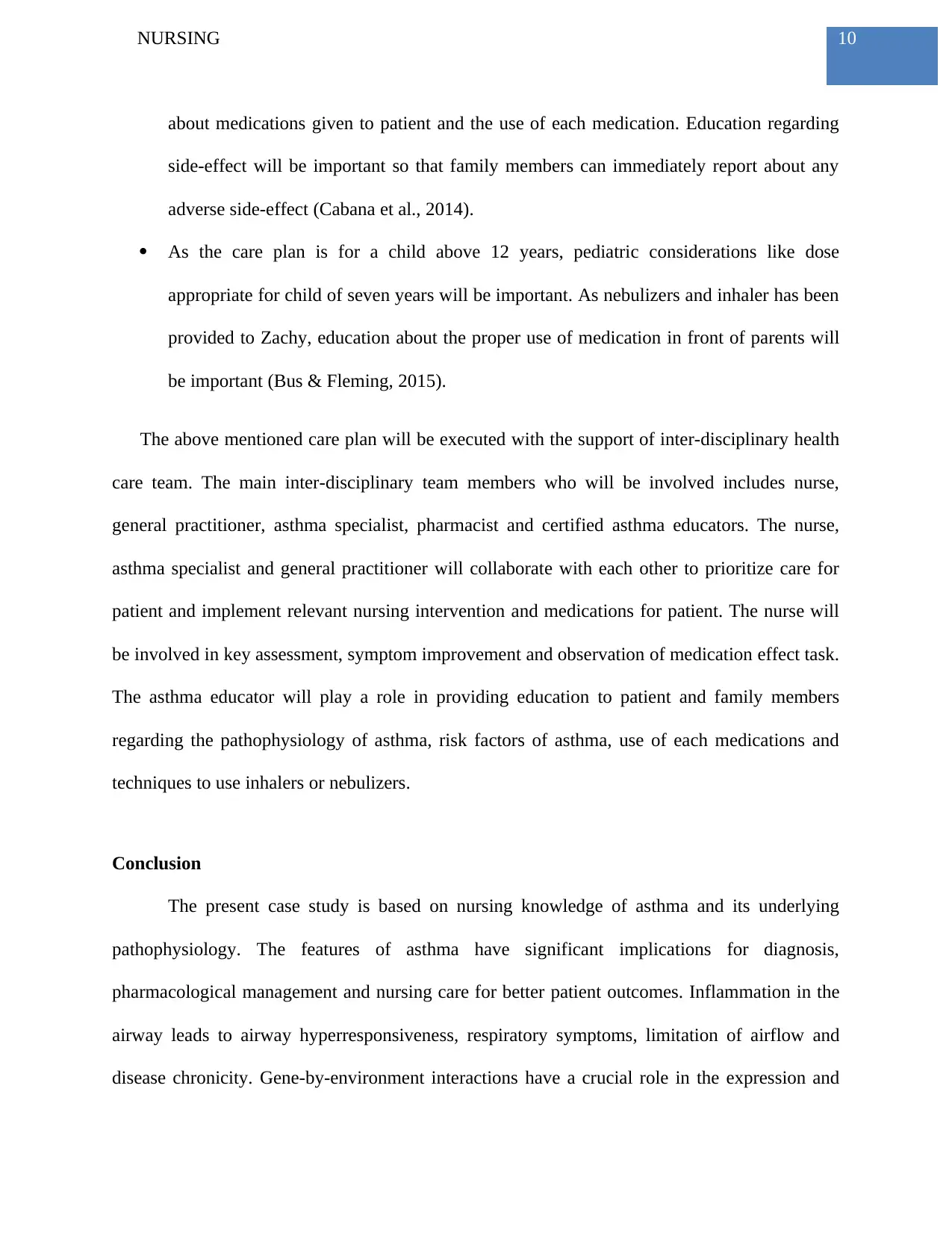
10NURSING
about medications given to patient and the use of each medication. Education regarding
side-effect will be important so that family members can immediately report about any
adverse side-effect (Cabana et al., 2014).
As the care plan is for a child above 12 years, pediatric considerations like dose
appropriate for child of seven years will be important. As nebulizers and inhaler has been
provided to Zachy, education about the proper use of medication in front of parents will
be important (Bus & Fleming, 2015).
The above mentioned care plan will be executed with the support of inter-disciplinary health
care team. The main inter-disciplinary team members who will be involved includes nurse,
general practitioner, asthma specialist, pharmacist and certified asthma educators. The nurse,
asthma specialist and general practitioner will collaborate with each other to prioritize care for
patient and implement relevant nursing intervention and medications for patient. The nurse will
be involved in key assessment, symptom improvement and observation of medication effect task.
The asthma educator will play a role in providing education to patient and family members
regarding the pathophysiology of asthma, risk factors of asthma, use of each medications and
techniques to use inhalers or nebulizers.
Conclusion
The present case study is based on nursing knowledge of asthma and its underlying
pathophysiology. The features of asthma have significant implications for diagnosis,
pharmacological management and nursing care for better patient outcomes. Inflammation in the
airway leads to airway hyperresponsiveness, respiratory symptoms, limitation of airflow and
disease chronicity. Gene-by-environment interactions have a crucial role in the expression and
about medications given to patient and the use of each medication. Education regarding
side-effect will be important so that family members can immediately report about any
adverse side-effect (Cabana et al., 2014).
As the care plan is for a child above 12 years, pediatric considerations like dose
appropriate for child of seven years will be important. As nebulizers and inhaler has been
provided to Zachy, education about the proper use of medication in front of parents will
be important (Bus & Fleming, 2015).
The above mentioned care plan will be executed with the support of inter-disciplinary health
care team. The main inter-disciplinary team members who will be involved includes nurse,
general practitioner, asthma specialist, pharmacist and certified asthma educators. The nurse,
asthma specialist and general practitioner will collaborate with each other to prioritize care for
patient and implement relevant nursing intervention and medications for patient. The nurse will
be involved in key assessment, symptom improvement and observation of medication effect task.
The asthma educator will play a role in providing education to patient and family members
regarding the pathophysiology of asthma, risk factors of asthma, use of each medications and
techniques to use inhalers or nebulizers.
Conclusion
The present case study is based on nursing knowledge of asthma and its underlying
pathophysiology. The features of asthma have significant implications for diagnosis,
pharmacological management and nursing care for better patient outcomes. Inflammation in the
airway leads to airway hyperresponsiveness, respiratory symptoms, limitation of airflow and
disease chronicity. Gene-by-environment interactions have a crucial role in the expression and
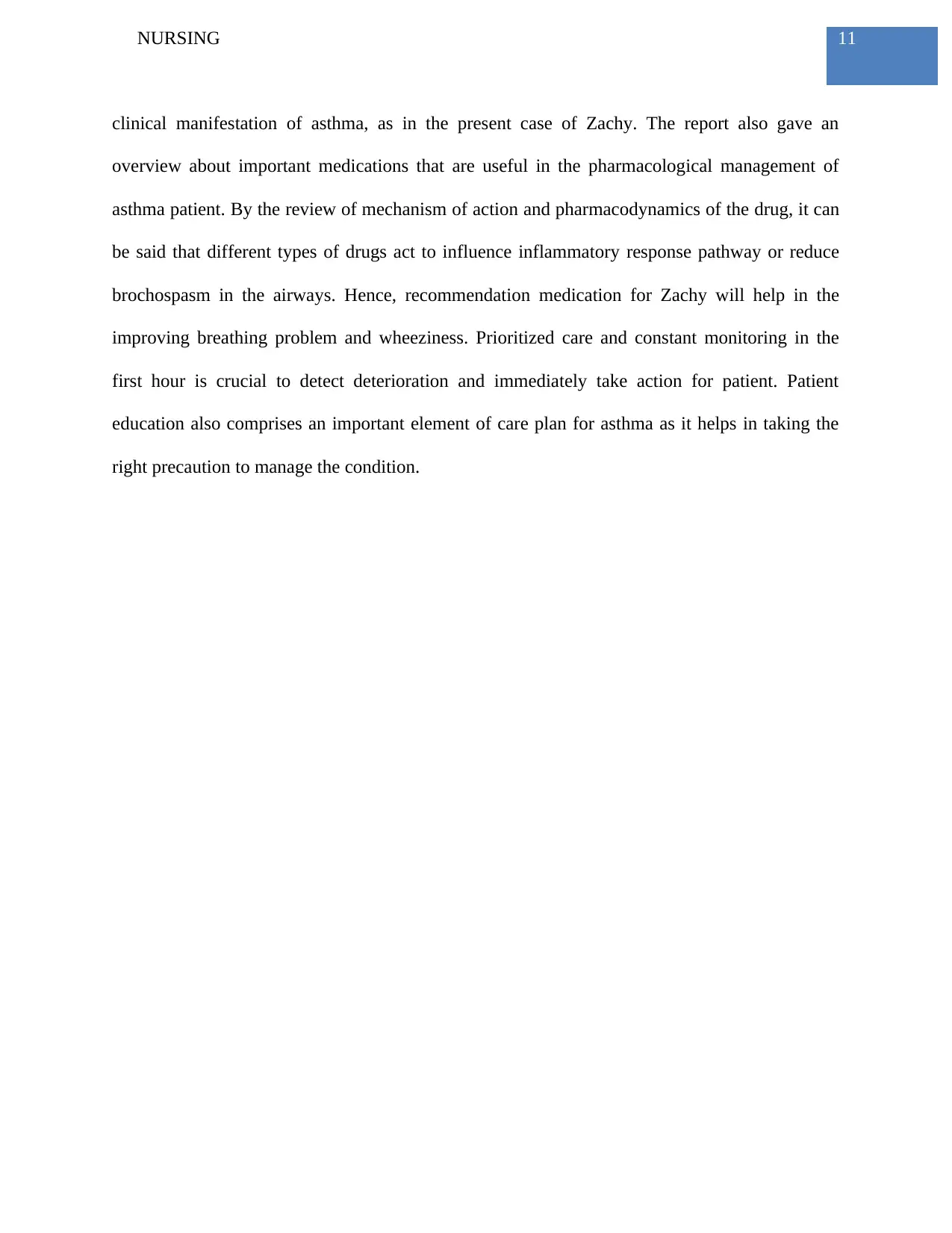
11NURSING
clinical manifestation of asthma, as in the present case of Zachy. The report also gave an
overview about important medications that are useful in the pharmacological management of
asthma patient. By the review of mechanism of action and pharmacodynamics of the drug, it can
be said that different types of drugs act to influence inflammatory response pathway or reduce
brochospasm in the airways. Hence, recommendation medication for Zachy will help in the
improving breathing problem and wheeziness. Prioritized care and constant monitoring in the
first hour is crucial to detect deterioration and immediately take action for patient. Patient
education also comprises an important element of care plan for asthma as it helps in taking the
right precaution to manage the condition.
clinical manifestation of asthma, as in the present case of Zachy. The report also gave an
overview about important medications that are useful in the pharmacological management of
asthma patient. By the review of mechanism of action and pharmacodynamics of the drug, it can
be said that different types of drugs act to influence inflammatory response pathway or reduce
brochospasm in the airways. Hence, recommendation medication for Zachy will help in the
improving breathing problem and wheeziness. Prioritized care and constant monitoring in the
first hour is crucial to detect deterioration and immediately take action for patient. Patient
education also comprises an important element of care plan for asthma as it helps in taking the
right precaution to manage the condition.
⊘ This is a preview!⊘
Do you want full access?
Subscribe today to unlock all pages.

Trusted by 1+ million students worldwide
1 out of 14
Related Documents
Your All-in-One AI-Powered Toolkit for Academic Success.
+13062052269
info@desklib.com
Available 24*7 on WhatsApp / Email
![[object Object]](/_next/static/media/star-bottom.7253800d.svg)
Unlock your academic potential
Copyright © 2020–2025 A2Z Services. All Rights Reserved. Developed and managed by ZUCOL.





